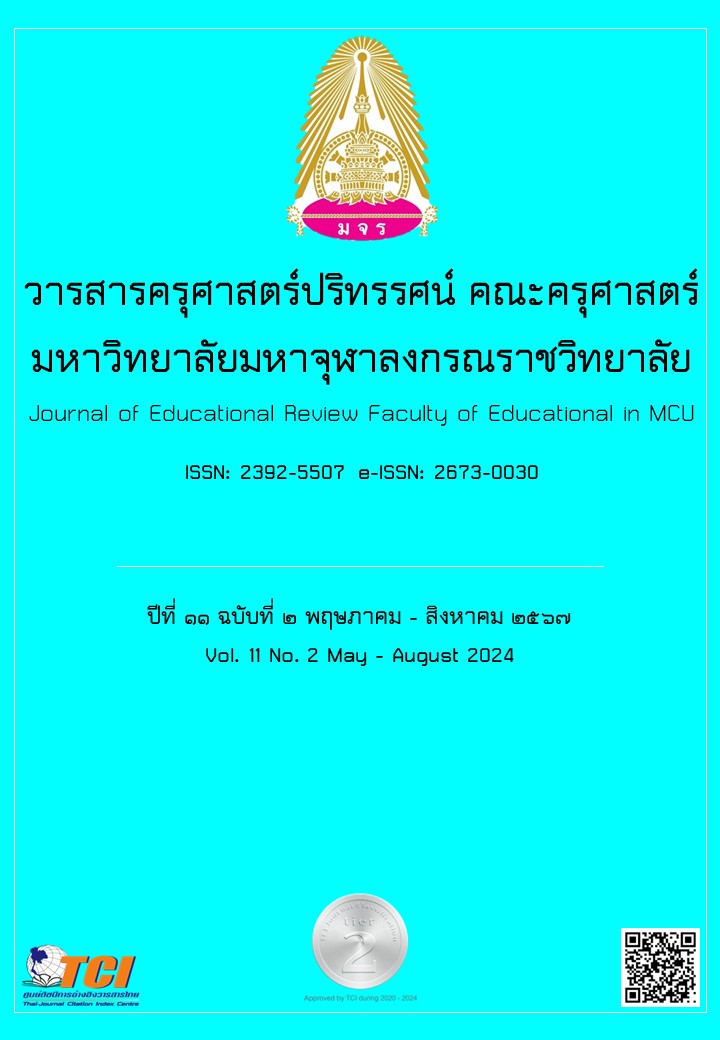THE INTEGRATION OF EDUTAINMENT AESTHETICS AND SCHOOL ADMINISTRATION
Main Article Content
Abstract
This article presented the integration of the principles of aesthetic education with school administration, which was the management of education in a world with high volatility. This was a result of the need to create stable economic and business potential. These things led to adjustment of the entire system in every sector, especially in education. Therefore, educational institution administrators were of paramount importance to the survival of education and were prepared to accommodate continuous changes. As a result, the administration of the educational institution had changed for the better. Including organizing teaching and learning processes that promoted experiences in aesthetic education as physical, emotional, and intellectual development by integrating with the principles of aesthetic education in management with science and art, including: 1) Pleasure: pleasure arising from the mind, 2) Ethics: beauty, goodness, joy, and enjoyment and sincerity, and 3) Function: considering the utility of art. This would bring benefits and be a guideline for the management of educational institutions that having art based on morality and ethics according to the way of life and culture of Thai people who had been nurtured by the teachings of Buddhism and to make the personnel in the educational institution feel joyful and happy with their daily educational duties, which would affect teaching students to have joy and happiness as well as within the family, society, and nation, respectively.
Article Details

This work is licensed under a Creative Commons Attribution-NonCommercial-NoDerivatives 4.0 International License.
ทัศนะและความคิดเห็นที่ปรากฏในบทความในวารสารฉบับนี้ถือเป็นความรับผิดชอบของผู้เขียนบทความนั้นเพียงผู้เดียว และไม่ถือเป็นทัศนะและความรับผิดชอบของกองบรรณาธิการ
กองบรรณาธิการขอสงวนสิทธิ์ในการคัดเลือกบทความลงตีพิมพ์และจะแจ้งให้เจ้าของบทความทราบหลังจากผู้ประเมินบทความตรวจอ่านบทความแล้ว
ต้นฉบับที่ได้รับการตีพิมพ์ในวารสารครุศาสตร์ปริทรรศน์ คณะครุศาสตร์ มหาวิทยาลัยมหาจุฬาลงกรณราชวิทยาลัย ถือเป็นกรรมสิทธิ์ของคณะครุศาสตร์ มหาวิทยาลัยมหาจุฬาลงกรณราชวิทยาลัย ห้ามนำข้อความทั้งหมดหรือบางส่วนไปพิมพ์ซ้ำ เว้นเสียแต่ว่าจะได้รับอนุญาตจากมหาวิทยาลัยฯ เป็นลายลักษณ์อักษร
References
กระทรวงศึกษาธิการ. (2551). แนวทางปฏิรูปการศึกษาของกระทรวงศึกษาธิการ. กรุงเทพมหานคร: ที.เอส.บี.โปรดักส์.
ธวัชซานนท์ ตาไธสง. (2546). หลักการศิลปะ. กรุงเทพมหานคร: สำนักพิมพ์วาดศิลป์.
บรรจง จันทรสา. (2527). ปรัชญากับการศึกษา. พิมพ์ครั้งที่ 5. กรุงเทพมหานคร: ไทยวัฒนาพานิช.
ประทีป ทับโทน. (2563). กลยุทธ์การบริหารสถานศึกษาด้วยความรับผิดชอบต่อสังคมของโรงเรียนสังกัดเทศบาล. ดุษฎีนิพนธ์ครุศาสตรดุษฎีบัณฑิต. มหาวิทยาลัยราชภัฎวไลยอลงกรณ์ ในพระบรมราชูปถัมภ์.
ปรียาพร วงศ์อนุตรโรงน์. (2555). การบริหารงานวิชาการ. กรุงเทพมหานคร: ศูนย์สื่อเสริมกรุงเทพ.
ปัญญากร เวชชศาสตร์. (2565). รูปแบบการบริหารเชิงกลยุทธ์เพื่อพัฒนาสถานศึกษาสู่ความเป็นเลิศ สังกัดองค์การบริหารส่วนจังหวัดปทุมธานี. วารสารครุศาสตร์ปริทรรศน์ คณะครุศาสตร์ มหาวิทยาลัยมหาจุฬาลงกรณราชวิทยาลัย. 9(1). 234.
พระพรหมคุณาภรณ์ (ป. อ. ปยุตฺโต). (2551). พจนานุกรมพุทธศาสตร์ ฉบับประมวลศัพท์. กรุงเทพมหานคร: ธนธัชการพิมพ์.
พระพรหมคุณาภรณ์ (ป. อ. ปยุตฺโต). (2551). พจนานุกรมพุทธศาสตร์ ฉบับประมวลธรรม. พิมพ์ครั้งที่ 16. กรุงเทพมหานคร: เอส. อาร์. พริ้นติ้ง แมส โปรดักส์.
พิสมัย รัตนวรรณ์. (2552). สุนทรียศาสตร์และสุทรียภาพ. แหล่งที่มา https://www.gotoknow.org/posts/292695 สืบค้นเมื่อ 10 ธ.ค. 2566.
มหาจุฬาลงกรณราชวิทยาลัย. (2539). พระไตรปิฎกภาษาไทย ฉบับมหาจุฬาลงกรณราชวิทยาลัย. กรุงเทพมหานคร: มหาจุฬาลงกรณราชวิทยาลัย.
เยาวเรศ ตระกูลวีระยุทธ. (2558). รูปแบบการบริหารสถานศึกษาขีดสมรรถะสูง สังกัดองค์กรปกครองส่วนท้องถิ่น. ดุษฎีนิพนธ์ครุศาสตรดุษฎีบัณฑิต. มหาวิทยาลัยราชภัฎวไลยอลงกรณ์ ในพระบรมราชูปถัมภ์.
วิรัตน์ พิชญไพบูลย์. (2536). ศิลปะเป็นมูลฐานสำคัญ. วารสารครุศาสตร์. 22(1). 11.
ศิลป์ พีระศรี. (2527). ศิลปะสงเคราะห์: พจนานุกรมศัพท์ศิลปะของชาวตะวันตก. กรุงเทพมหานคร: โรงพิมพ์รุ่งเรืองธรรม.
สนามพล พรมกอง. (2559). การพัฒนารูปแบบการเรียนการสอนเพื่อส่งเสริมทางด้านสุนทรียภาพสำหรับนักศึกษาระดับปริญญาตรี. ดุษฎีนิพนธ์ปรัชญาดุษฎีบัณฑิต. มหาวิทยาลัยเทคโนโลยีพระจอมเกล้าพระนครเหนือ.
สำนักงานคณะกรรมการการศึกษาขั้นพื้นฐาน. (2553). การจัดระบบบริหารและสารสนเทศภายในสถานศึกษา. กรุงเทพมหานคร: สำนักงานคณะกรรมการการศึกษาขั้นพื้นฐาน.
สำนักงานคณะกรรมการการศึกษาแห่งชาติ. (2545). พระราชบัญญัติการศึกษาแห่งชาติ พ.ศ. 2542 และที่แก้ไขเพิ่มเติม (ฉบับที่ 2) พ.ศ. 2545. กรุงเทพมหานคร: พริกหวานกราฟฟิค.
สำนักงานราชบัณฑิตยสภา. (2541). พจนานุกรมศัพท์ศิลป์: อังกฤษ-ไทย ฉบับราชบัณฑิตยสถาน. กรุงเทพมหานคร: ศิริวัฒนาอินเตอร์พริ้นท์.
อารี สุทธิพันธุ์. (2551). ผลึกความคิดศิลปะ. กรุงเทพมหานคร: สำนักพิมพ์มหาวิทยาลัยศรีนครินทรวิโรฒ.
Bates, J. K. (2000). Becoming an Art Teacher. USA: Wadsworth, a Division of Thomson Leaming.
Bush, T. (2006). The National Collese for School Leadership: A Successful English Innovation. Phi Delta Kappan. 87(7). 1.
Campbell, R. F. (1977). Introduction to Educational Administration. 6 ed. Boston: Allyn and Baco.
Good, Center V. (1973). Dictionary of Education. New York: McGraw – Hill.
Sergiovanni, T. J. & Burlingame, M. (1992). Educational Governance and Administration. 3rd ed. Needham Heights. MA: Allyn and Bacon.


